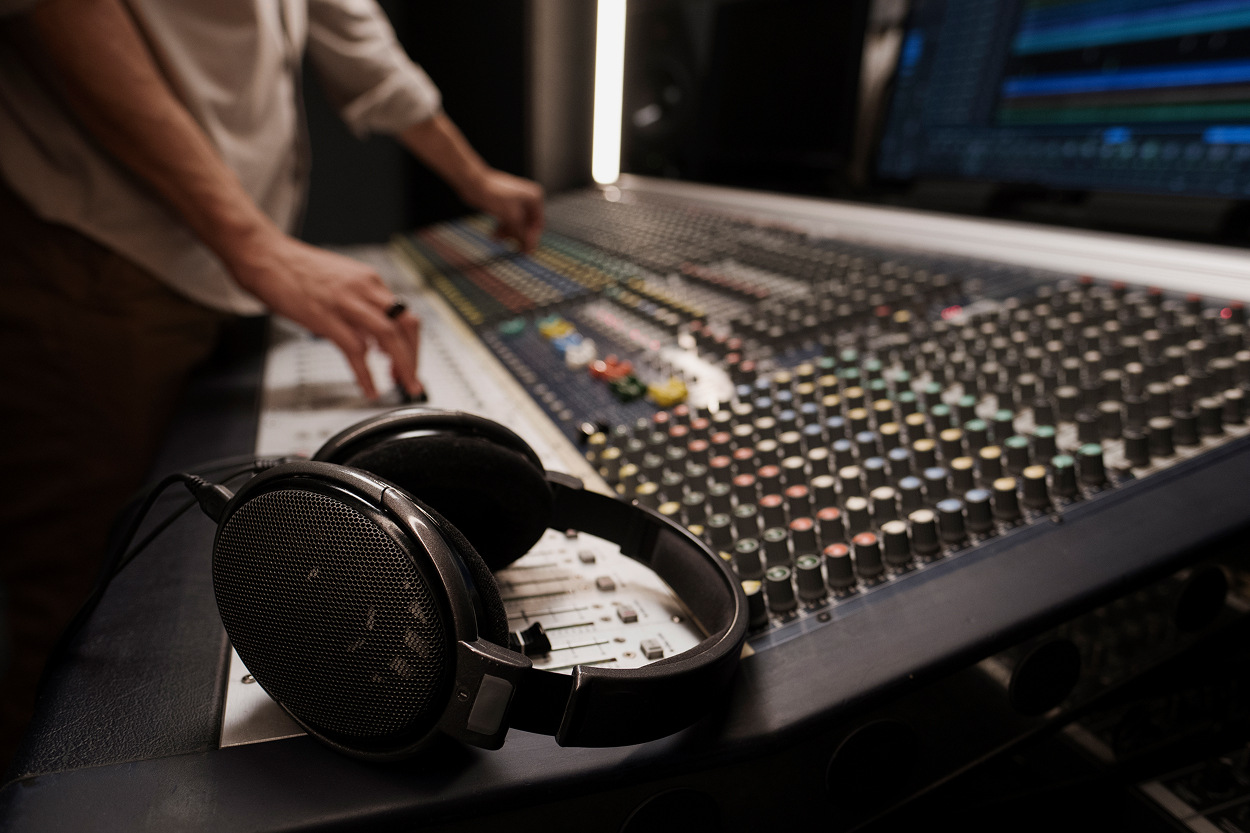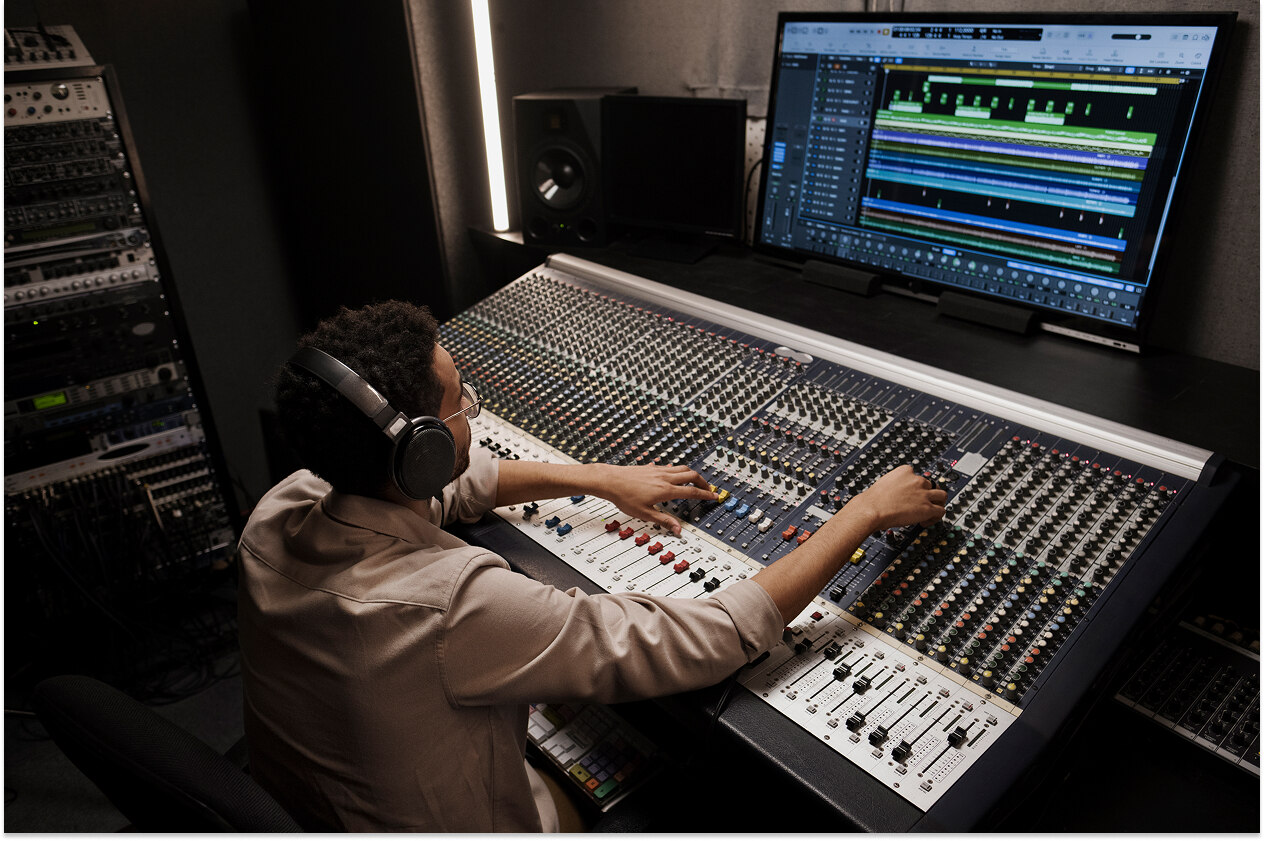FPGA-Based Audio Processing: Real-Time DSP for Broadcasting and Telecom

Audio quality and processing latency are critical in professional broadcasting and telecom systems. Whether it’s live studio mixing, real-time encoding, VoIP communication, or digital radio transmission, these applications demand deterministic, high-speed audio signal processing.
To meet these requirements, engineers are increasingly turning to FPGAs (Field-Programmable Gate Arrays). Unlike general-purpose CPUs or even dedicated DSP chips, FPGAs offer a powerful combination of low latency, parallelism, and hardware-level customization—making them ideal for audio processing workloads that demand both flexibility and performance.
This article explores how FPGA-based solutions are used in modern audio processing systems and how Promwad supports clients building custom FPGA audio pipelines.
Why use FPGAs for audio signal processing?
FPGAs have become the go-to platform for real-time signal processing in latency-sensitive environments. Compared to traditional DSPs or SoCs, FPGAs offer:
- Deterministic low-latency performance
FPGA designs operate at the hardware level without the variability of operating system scheduling or cache stalls. Audio paths can be fully pipelined and parallelized, enabling sub-millisecond end-to-end latency. - Parallelism and high channel density
You can process multiple audio channels in parallel, each with independent EQ, dynamic range compression, or routing logic. - Flexible I/O support
FPGAs support a wide variety of digital audio interfaces: I2S, AES3, TDM, MADI, SPDIF, and even custom streaming protocols over Ethernet or optical links. - Integration with video and control logic
FPGAs are already widely used for video processing in broadcasting. Combining audio and video on a single programmable platform simplifies integration and timing alignment. - Reconfigurability
Unlike ASICs, FPGA designs can be updated post-deployment, making it easier to introduce new codecs, filters, or protocols.
Common use cases in broadcasting and telecom
- Live mixing consoles
Perform digital mixing, gain control, EQ, filtering, and signal routing with minimal latency. - Audio-over-IP (AoIP) devices
Implement AES67, Dante, or Ravenna on FPGA to manage networked audio streams with precise timing. - Telecom voice processing
Real-time echo cancellation, noise suppression, and VoIP packetization in gateways and base stations. - Broadcast automation systems
Process multiple simultaneous audio feeds for encoding, monitoring, or dynamic switching. - Audio signal conditioning for transmission
Apply AGC, leveling, and pre-emphasis before RF or satellite modulation stages.

Key building blocks of FPGA audio processing systems
Designing an FPGA-based audio system typically involves these elements:
1. Digital audio interfaces
FPGAs can directly handle bit-level protocols (I2S, TDM) or interface with audio ADCs/DACs. Support for high-speed SERDES and LVDS is also common.
2. Fixed-point or floating-point DSP blocks
Modern FPGAs include dedicated DSP slices or MAC units optimized for FIR/IIR filtering, FFT, matrix math, and other core audio functions.
3. Clock domain synchronization
Professional audio requires stable, low-jitter clocks. FPGAs can implement PLLs, SRCs, and word clock recovery to manage synchronization across digital systems.
4. Audio codecs and compression
Implement or accelerate AAC, Opus, G.711, or custom codecs in FPGA fabric or soft processors (e.g., MicroBlaze, Nios II).
5. Control and monitoring
Use embedded soft cores or external MCU interfaces for gain control, channel switching, or telemetry.
Real-world example: Broadcast audio router with FPGA core
Promwad recently supported a client building a multi-channel audio routing platform for TV studios. Requirements included:
- 128 audio channels in and out
- Dynamic signal routing
- Gain and mute control per channel
- AES3, MADI, and Dante input/output
- <1ms total latency
- Web-based UI for configuration
We implemented a Xilinx-based architecture with:
- Parallel DSP pipelines for all audio channels
- Real-time clock-domain bridging
- SPI interface to control MCU
- Support for hot firmware upgrades
The system was fully scalable and compatible with studio-grade timing requirements (Blackburst, Word Clock, PTP).
Design and integration tips
- Use vendor IP wisely: Most major FPGA vendors offer audio-optimized IP blocks (e.g., FIR compilers, ASRC, audio codecs).
- Manage latency deterministically: Pipeline all stages and measure end-to-end delay; avoid dynamic memory access where possible.
- Plan for redundancy: In broadcast systems, failover paths and watchdog timers are mandatory.
- Design for debug: Include test points, LED status outputs, and soft scopes to validate audio paths in real time.
- Integrate with control systems: Expose control parameters over UART, SPI, I2C, or embedded Ethernet web servers.
While deterministic DSP pipelines remain the foundation of professional audio processing, broadcast architectures are evolving beyond audio-only workloads. By 2026, many systems combine real-time audio DSP with RF processing, IP media handling, and AI-assisted signal analysis within a single FPGA-centric architecture. Instead of treating audio, RF, and intelligence as separate subsystems, next-generation designs collapse these stages into tightly synchronized pipelines built on RFSoC platforms and AI-DSP hybrids. This broader architectural shift is explored in a 2026 analysis of FPGA pipelines for next-generation broadcast systems, which shows how traditional audio DSP principles scale into full media chains with predictable timing and integrated intelligence.
How Promwad helps with FPGA audio solutions
Promwad offers full-cycle development for audio-centric embedded systems:
- Architecture design for real-time DSP on Xilinx, Intel, or Lattice FPGAs
- RTL development in VHDL/Verilog or HLS with simulation and timing closure
- Integration with video pipelines and synchronization standards (PTP, AES67)
- Hardware platform design with audio-specific IO and low-jitter clocks
- Embedded Linux + FPGA hybrid systems (Zynq, Cyclone V SoC)
- Enclosure, thermal, and EMI design for professional audio applications
If your FPGA audio pipeline is only one part of a larger broadcast chain, it’s important to validate the full system end to end — from hardware interfaces and drivers to timing, transport, and cross-platform control. Our broadcast technology solutions cover both broadcast hardware and software development, including low-latency media pipelines and standards alignment across mixed-vendor environments. This is especially useful when audio must coexist with IP workflows and studio timing requirements, so performance and interoperability stay predictable as you scale.
Whether you're building a studio mixing system, a telecom audio gateway, or a networked media processor, we help you achieve real-time performance, low power, and broadcast-grade reliability.
Conclusion
FPGA-based audio processing is a powerful approach for industries where latency, channel density, and real-time reliability are non-negotiable. In broadcasting and telecom, FPGAs enable scalable, deterministic, and reconfigurable platforms that outperform traditional DSP solutions.
If you're planning your next audio hardware platform, contact Promwad. We’ll help you design and build FPGA-powered audio pipelines that meet the highest standards of performance and integration.
Our Case Studies
